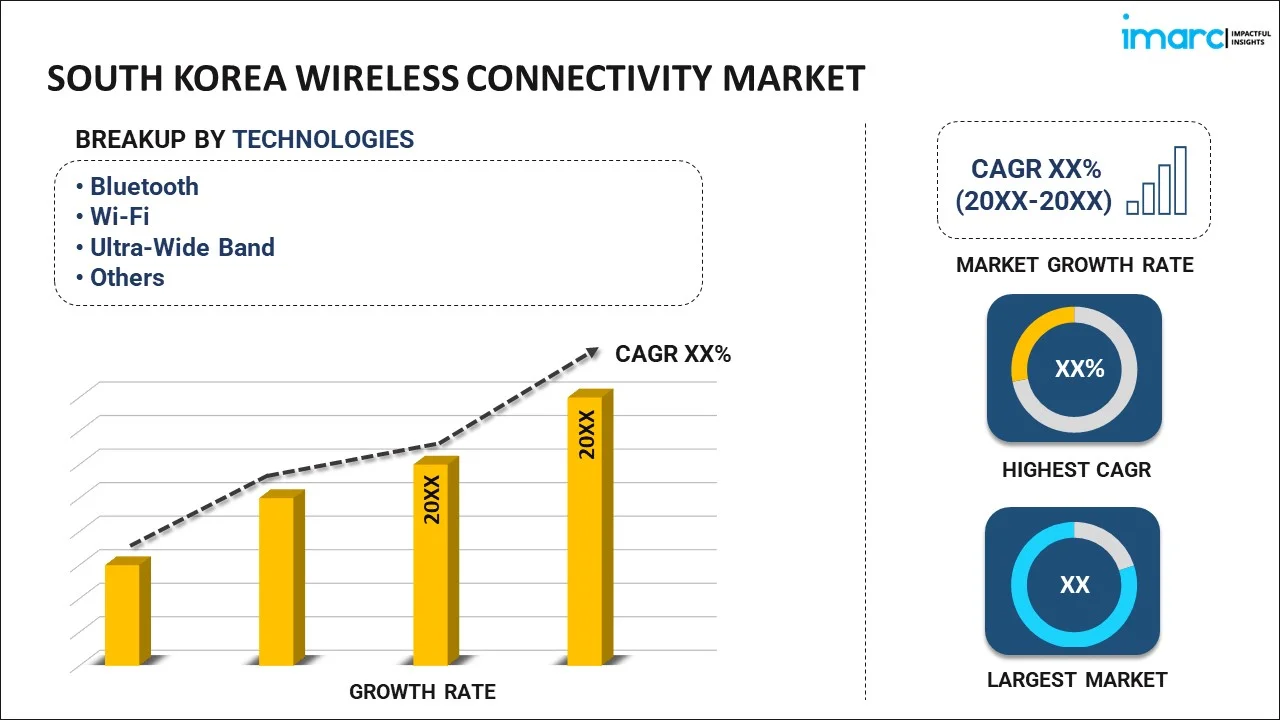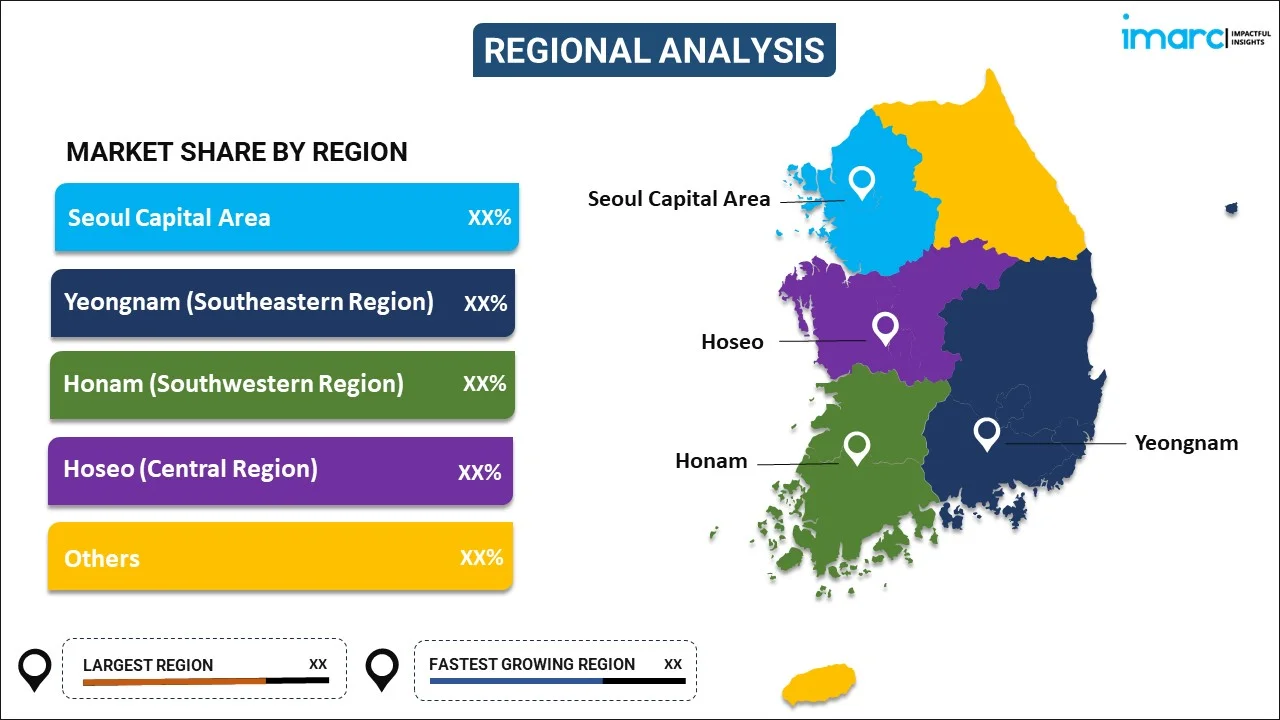
South Korea Wireless Connectivity Market Report by Technology (Bluetooth, Wi-Fi, Ultra-Wide Band, NFC, Cellular, Zigbee, GPS, and Others), Network Type (Wireless Wide Area Network (WWAN), Wireless Personal Area Network (WPAN), Wireless Local Area Network (WLAN)), End User (Automotive and Transportation, Building Automation, Consumer Electronics and Wearables, Energy and Utilities, Healthcare, Industrial, IT and Telecom, and Others), and Region 2025-2033
Market Overview:
South Korea wireless connectivity market size reached USD 2.6 Billion in 2024. Looking forward, IMARC Group expects the market to reach USD 7.5 Billion by 2033, exhibiting a growth rate (CAGR) of 11.3% during 2025-2033. The inflating need for facilitating convenient information access to support network updates for adapting to new configurations and reducing dependence on intricate cable setups that may pose safety risks is primarily driving the regional market.
|
Report Attribute
|
Key Statistics
|
|---|---|
|
Base Year
|
2024
|
|
Forecast Years
|
2025-2033
|
|
Historical Years
|
2019-2024
|
|
Market Size in 2024
|
USD 2.6 Billion |
|
Market Forecast in 2033
|
USD 7.5 Billion |
| Market Growth Rate 2025-2033 | 11.3% |
Wireless connectivity pertains to a computer network that typically utilizes radio waves to facilitate communication among network nodes, enabling devices to stay linked to the network while moving within the coverage area. This method eliminates the need for cables, wires, and cords in establishing connections. In comparison to wired networks, wireless connectivity offers superior mobility and robust access to Wi-Fi hotspots in various locations. Additionally, it is simple to install, providing a flexible and cost-effective solution that facilitates information access, allows network updates for new configurations, and minimizes reliance on cumbersome cable setups that pose safety risks. Leveraging properties like these, end-users employ wireless connectivity for purposes such as enhancing security, conducting tracking activities, accessing the internet, and connecting devices using solutions like Wi-Fi, Bluetooth, and Z-Wave. Presently, wireless connectivity is commercially available in cellular machine-to-machine (M2M), satellite, and WLAN varieties.
South Korea Wireless Connectivity Market Trends:
The South Korea wireless connectivity market stands at the forefront of technological evolution, embodying a network paradigm that relies on radio waves for seamless communication among network nodes. This innovative approach allows devices to maintain connectivity while moving within the network's coverage area, eliminating the constraints of cables and cords. Compared to wired networks, wireless connectivity in South Korea offers unparalleled mobility and robust access to Wi-Fi hotspots in diverse locations. Additionally, the ease of installation, flexibility, and cost-effectiveness make wireless connectivity a preferred solution in South Korea. Besides this, the commercial availability of wireless connectivity in South Korea spans cellular machine-to-machine (M2M), satellite, and WLAN types, catering to diverse connectivity needs. End-users in South Korea leverage wireless connectivity to enhance security measures, conduct tracking activities, access the internet seamlessly, and interconnect devices through technologies like Wi-Fi, Bluetooth, and Z-Wave. This market's dynamic nature reflects the nation's commitment to staying at the forefront of technological advancements, fostering an environment where connectivity is not just a convenience but a strategic necessity. As South Korea continues to emphasize technological innovation, the wireless connectivity market is expected to bolster over the forecasted period.
South Korea Wireless Connectivity Market Segmentation:
IMARC Group provides an analysis of the key trends in each segment of the market, along with forecasts at the country level for 2025-2033. Our report has categorized the market based on technology, network type, and end user.
Technology Insights:

- Bluetooth
- Wi-Fi
- Ultra-Wide Band
- NFC
- Cellular
- Zigbee
- GPS
- Others
The report has provided a detailed breakup and analysis of the market based on the technology. This includes bluetooth, wi-fi, ultra-wide band, NFC, cellular, zigbee, GPS, and others.
Network Type Insights:
- Wireless Wide Area Network (WWAN)
- Wireless Personal Area Network (WPAN)
- Wireless Local Area Network (WLAN)
A detailed breakup and analysis of the market based on the network type have also been provided in the report. This includes wireless wide area network (WWAN), wireless personal area network (WPAN), and wireless local area network (WLAN).
End User Insights:
- Automotive and Transportation
- Building Automation
- Consumer Electronics and Wearables
- Energy and Utilities
- Healthcare
- Industrial
- IT and Telecom
- Others
The report has provided a detailed breakup and analysis of the market based on the end user. This includes automotive and transportation, building automation, consumer electronics and wearables, energy and utilities, healthcare, industrial, IT and telecom, and others.
Regional Insights:

- Seoul Capital Area
- Yeongnam (Southeastern Region)
- Honam (Southwestern Region)
- Hoseo (Central Region)
- Others
The report has also provided a comprehensive analysis of all the major regional markets, which include Seoul Capital Area, Yeongnam (Southeastern Region), Honam (Southwestern Region), Hoseo (Central Region), and Others.
Competitive Landscape:
The market research report has also provided a comprehensive analysis of the competitive landscape. Competitive analysis such as market structure, key player positioning, top winning strategies, competitive dashboard, and company evaluation quadrant has been covered in the report. Also, detailed profiles of all major companies have been provided.
South Korea Wireless Connectivity Market Report Coverage:
| Report Features | Details |
|---|---|
| Base Year of the Analysis | 2024 |
| Historical Period | 2019-2024 |
| Forecast Period | 2025-2033 |
| Units | Billion USD |
| Scope of the Report | Exploration of Historical and Forecast Trends, Industry Catalysts and Challenges, Segment-Wise Historical and Predictive Market Assessment:
|
| Technologies Covered | Bluetooth, Wi-Fi, Ultra-Wide Band, NFC, Cellular, Zigbee, GPS, Others |
| Network Types Covered | Wireless Wide Area Network (WWAN), Wireless Personal Area Network (WPAN), Wireless Local Area Network (WLAN) |
| End Users Covered | Automotive and Transportation, Building Automation, Consumer Electronics and Wearables, Energy and Utilities, Healthcare, Industrial, IT and Telecom, Others |
| Regions Covered | Seoul Capital Area, Yeongnam (Southeastern Region), Honam (Southwestern Region), Hoseo (Central Region), Others |
| Customization Scope | 10% Free Customization |
| Post-Sale Analyst Support | 10-12 Weeks |
| Delivery Format | PDF and Excel through Email (We can also provide the editable version of the report in PPT/Word format on special request) |
Key Questions Answered in This Report:
- How has the South Korea wireless connectivity market performed so far and how will it perform in the coming years?
- What is the breakup of the South Korea wireless connectivity market on the basis of technology?
- What is the breakup of the South Korea wireless connectivity market on the basis of network type?
- What is the breakup of the South Korea wireless connectivity market on the basis of end user?
- What are the various stages in the value chain of the South Korea wireless connectivity market?
- What are the key driving factors and challenges in the South Korea wireless connectivity?
- What is the structure of the South Korea wireless connectivity market and who are the key players?
- What is the degree of competition in the South Korea wireless connectivity market?
Key Benefits for Stakeholders:
- IMARC’s industry report offers a comprehensive quantitative analysis of various market segments, historical and current market trends, market forecasts, and dynamics of the South Korea wireless connectivity market from 2019-2033.
- The research report provides the latest information on the market drivers, challenges, and opportunities in the South Korea wireless connectivity market.
- Porter's five forces analysis assist stakeholders in assessing the impact of new entrants, competitive rivalry, supplier power, buyer power, and the threat of substitution. It helps stakeholders to analyze the level of competition within the South Korea wireless connectivity industry and its attractiveness.
- Competitive landscape allows stakeholders to understand their competitive environment and provides an insight into the current positions of key players in the market.
Need more help?
- Speak to our experienced analysts for insights on the current market scenarios.
- Include additional segments and countries to customize the report as per your requirement.
- Gain an unparalleled competitive advantage in your domain by understanding how to utilize the report and positively impacting your operations and revenue.
- For further assistance, please connect with our analysts.
 Request Customization
Request Customization
 Speak to an Analyst
Speak to an Analyst
 Request Brochure
Request Brochure
 Inquire Before Buying
Inquire Before Buying




.webp)




.webp)












